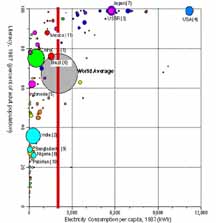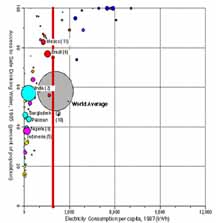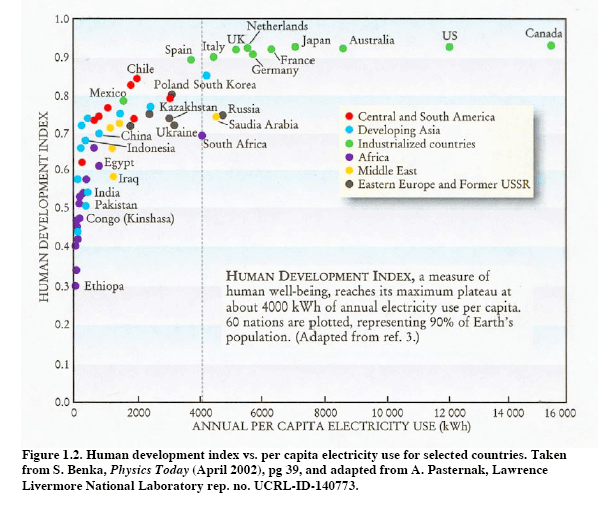 THE GENI MODELThe Interconnection of Global Power Resources to Obtain an Optimal Global Sustainable Energy Solution
BACKGROUND:As a result of early research, GENI identified a major limitation for the industry's wider use of interconnection of large scale, renewable energy resources: the lack of a suitable, validated computer simulation model to demonstrate the cost/benefit of various scenarios which would include a comparison with other energy scenarios, for example, those of the World Energy Council. So in August of 1992, a Computer Simulation Model was conceived to be this management tool. It would factor in quality of life indicators including infant mortality, life expectancy, literacy and safe drinking water, as well as criteria for meeting the environmental standards set forth by the Earth Summit Agenda 21 and signed by nations around the world. By: Paul-Michael Dekker, Peter Meisen, Amy B. Bruton
ABSTRACTThe Global Energy Network Institute (GENI) model quantifies the economic, environmental, and social benefits of developing remote renewable energy sources and linking them to population centers via long distance electrical transmission lines. The model investigates an optimal sustainable global energy solution by comparing the GENI alternative to those alternatives presented by the World Energy Council (WEC) and others. This paper describes the work in progress accomplished by the GENI organization. The correlation between electricity and quality of life indicators is presented. Abbreviated problem and project definitions are presented. KEY WORDSInterconnected Electric Utility Systems, Wheeling, Ultra High Voltage(UHV) Transmission; Real-time Decision-Making, Computer Simulation; Renewable Energy, Sustainable Energy Development; Buckminster Fuller, World Game; International Trade, GATT; Global Development, Energy Consumption; Fresh Water, Safe Drinking Water, Pollution, Deforestation, Desertification, Acid Rain, Greenhouse Effect; Poverty, Hunger, Population Control, Life Expectancy, Infant Mortality, Birth Control, Adult Literacy, Global Education, Quality of Life. OVERVIEWIn 1969, Dr. R Buckminster Fuller proposed a global electric energy grid as "the highest priority objective" of the World Game.(1) The purpose statement of the World Game is "to make the world work for 100% of humanity in the shortest possible time without ecological damage or the disadvantage to anyone." Using Dr. Fuller's Dymaxion Map, it is more easily seen how this transmission scheme would link regions and neighboring continents (figure 1). In 1971, the United Nations Natural Resources Council corroborated this global option, but it was buried due to Cold War politics at that time. GENI asserts that electricity is essential for a high quality of life. 
Figure 1. Dymaxion™ Map Currently 82% of electricity is generated by burning finite nonrenewable fuels (fossil 77.1%, nuclear 4.9%).(2) Renewable energy is extremely abundant, relatively inexhaustible,(3) and potentially less polluting than nonrenewable. Technologies for converting this energy to electricity are now becoming cost competitive with fossil fuel generation.(4) Unfortunately, most large scale renewable energy sites are located far from population centers.(5) However, current transmission line technology is now capable of economically delivering electricity as far as 4000 miles (7000 km) from the source.(6) From a technological viewpoint, interconnection of renewable energy sources is a viable and feasible energy alternative today. UTILITY BENEFITSOver the past three decades, electric power interconnections, known in energy circles as "grids", have become increasingly widespread. Transmission technology has improved greatly and the benefits of interdependent electrical utility systems have been realized. Significant economic benefits have been achieved through interconnected systems (e.g. in North America, Europe, the former USSR, Japan, New Zealand and Australia). Electric power interconnections provide many benefits, including:
INTERCONNECTED ELECTRICAL SYSTEMSCurrent research from CIGRE,(7) (International Conference on Large High Voltage Electric Systems), indicates that long-distance transmission can be made reliable and economically successful up to 7000 kilometers with HVDC, (High-Voltage Direct Current), and 4000 kilometers with HVAC, (High-Voltage Alternating Current). This permits inter-regional and even intercontinental power delivery from remote sites where large renewable energy sources are found. Observed benefits of existing intra-regional interconnections include:
Concern for resource security and other factors has resulted in the international energy trade of fossil fuels and uranium with a relatively small amount of trade in electricity.(8) Since many countries are still unwilling to rely on too large a percentage of imported power for national security reasons, foreign power usually displaces only the most expensive peaking generation units. Thus the imported power need only be cheaper than the buyer's marginal cost for peaking power to create a profitable economic win-win situation. Power is presently being purchased and sold every day in order to level demand and alleviate power shortages within sub-regional systems. For example, in the U.S. and Canada, the North American Electric Reliability Council (NAERC), and in Europe, the Union for the Coordination of Production on Transmission of Electricity (UCPTE), provide the coordination standards for large intra-regional grids. The inter-regional exports of excess power from developing nations can provide less expensive peaking electricity for the industrialized countries and financial resources for the developing countries. The potential exists to expand electricity exchange considerably via mechanisms like GATT (General Agreements on Trade and Tariffs), NAFTA (North American Free Trade Agreement) and APEC (Asian Pacific Economic Cooperation). Approximately 80 percent of all generation in the world is based on non-renewable fuels, whose emissions have deleterious effect on the environment (the creation of greenhouse effect gases, acid rain and toxic waste). Greenhouse gas emissions could be reduced by one third from present levels by switching to renewable energy sources. A realistic and achievable 2000 TWh (tera-watt hours) per annum of renewable energy (primarily hydro-electric) could be interconnected into existing systems(9). Significant progress towards a low emission sustainable energy future is possible through the extensive use of interconnections. With numerous sites around the world that contain energy sources like hydro, tidal, solar, wind and geothermal, it is reasonable to project the benefits for the future if these renewable resource sites are connected into existing grids. An inventory of some of the best renewable resources shows them to be located throughout much of the developing world -- Latin America, Africa and Asia, as well as the northern latitudes of Canada, Alaska and Russia. Billions of dollars could be saved by sharing this untapped potential, and to a large extent, much future demand could be satisfied by wheeling (trading electricity by buying it from one area, moving it through a second area and selling it to third area) rather than by building new generation plants. Savings from wheeled power are well established and are reflected in reduced customer costs for the buyer and reduced unit costs for the seller. Energy is a vital component to population stability. The world's environment is rapidly moving out of balance with respect to its ability to support its exploding population. Most projections have world population increasing to 8.5 billion by 2020,(10) with almost all of the growth coming from the developing countries. While population control could relieve many of the environmental problems facing the world, it is unreasonable to expect governmental decrees to accomplish this goal. 
Figure 2. Projected Global Population Population control will occur due to two factors. The first would be that people around the world must move towards a rational approach to family planning. Secondly, enough energy must be made available for basic infrastructure needs such as development of clean or fresh water resources, sanitation facilities and refrigeration of food and medicine. In developing countries, large families are deemed necessary to ensure that the survivors will be around to help with the work of sustaining the family, as well as to take care of parents when they are old. These "insurance births" are required as well because infant mortality is high due to inadequate health care, non-potable water and malnutrition. Thus, not only are infants at risk, but children as a group. When food and health-care systems can be sustained, fewer children are necessary. Each member of the family can then function as working and contributing members of the community. This causes birth rates to fall along with infant mortality.(11) ALTERNATIVE ENERGY FUTURESCommon to all social systems with which the developed world is familiar, energy in the form of electricity provides for the efficient utilization of resources to supply food, shelter, health care, sewage disposal, transportation, communication and education. Clearly, power by wire is a primary measure of modern society. However, people in developing nations are more concerned with survival than with environmental protection. When the projected global energy demand (figure 3) is compared to the three alternative energy futures[figure 4], put forward by the World Energy Council, none meet any accepted environmental sustainability standard. Many of the large renewable resources are located in developing countries. With optimal global resource development, excess power can be exported to developed nations. This would provide income for developing countries and energy to drive their economies.(12) 
Figure 3. Projected Global Energy Demand 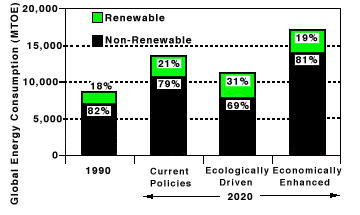
Figure 4. Alternative Energy Futures (WEC) Interconnections are worth in excess of $20 billion annually to the U.S. economy. What's been missing from the models reviewed to date is the quantitative analysis that compares the costs and benefits of the GENI scenario versus those of the WEC,(13) IIASA (International Institute of Applied Systems Analysis),(14) and Greenpeace.(15) A FRAMEWORK FOR THE PROBLEMSeveral questions surround the problem of finding the optimal sustainable global energy solution. Many detailed social and technical questions are yet to be posed. A summary of factors influencing the model are covered here. The GENI model is divided into ten modules: the Regional Modules (figure 5) and the Global Module (figure 6). The Global Module and 9 Regional Modules are broken down into significantly greater detail by GENI than can be shown here. 
Figure 5. Simplified Regional Sector (one for each of nine world regions) 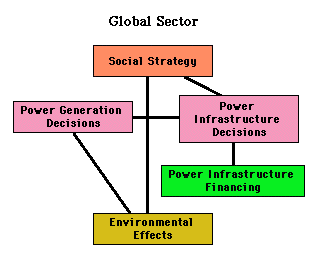
Figure 6. Simplified Global Sector The GENI model segments the world into the nine geographical regions used by the WEC.(16) Each of the nine regional modules addresses:
The interconnected nine regions will be linked to the Global Model, and a more detailed breakdown by region will follow for specific project proposals. The interfaces between regions model:
The global sector module examines:
The issues that have been reviewed by GENI include:
A DECISION-MAKING TOOLThe GENI model would be used as a tool for making electricity infrastructure planning decisions, such as:
Since large population groupings are not evenly distributed around the globe, extended transmission systems are required for the efficient delivery of renewable energy from remote locations. Isolated interconnected inter-regional systems have been modeled by power system planners. The interconnection of remote renewable energy resources around the world has not been integrated globally, or correlated with econometric or climatic models. The GENI model is the first comprehensive global model analyzing this energy option. The results will support integrated energy resource planning by quantifying the effects of the method of power generation, and the resultant social, economic, health, and environmental impacts. The objective function of the model includes satisfying the world's energy demand while minimizing the supply flow costs of the transmission and generation systems. METHODOLOGYMany models have been developed to simulate various energy related scenarios in developed and developing countries, such as:
The constraints of these models limit them to econometric and climatic biases. One example, is the Grand Inga project, which proposes tapping the 40 MW potential of the Zaire River for use in Africa, and exporting the excess capacity to Europe and the Middle East. Some models determine the standard of living by studying the causes and effects of indicators, such as:
For instance, the social benefits would be significant for developing countries in Africa since the energy produced comes from a renewable source and the income from energy sales would provide needed revenue for programs intended to alleviate poverty in the region. The export of a sustainably developed renewable resource does not reduce the potential richness of the producing country and therefore does not compromise its future development. Instead the scheme provides impetus for continued development, plus the ability to repay existing debt.(17) From the World Game, developed by Dr. R. Buckminster Fuller, the interconnection of renewable energy resources was the highest priority objective. It was revealed that the standard of living is a function of sufficient kilowatt-hours per capita.(18) There appears to be a threshold reached at about 2000 kWh per capita per year that moves a country from developing to developed status. It is our purpose to validate this assumption through the GENI model. In the GENI model, we test the hypothesis that electricity is the essential element in determining the qualitative level of each of these indicators... The method used to examine the GENI scenario is to:
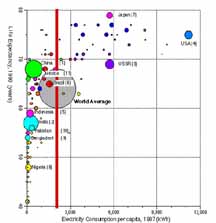 CLICK HERE TO SEE FULL PAGE IMAGE Figure 7. Life Expectancy vs. Electricity Increasing availability and use of electricity is generally associated with a higher "quality of life." While different people and cultures disagree on how to define quality of life, several measures are commonly used. Here we will examine four of these - life expectancy, infant mortality ( the number of children per 1000 live births who die in their first year), adult literacy rate, and availability of safe drinking water. Life expectancy defintely increases with energy consumption. Once a nation reaches 2000 kWh per capita, the average life expectancy is about 75 years. China's emphasis on controlling birth rates and improving health care has resulted in a higher then average life expectancy based on their energy consumption. The SE Asian nations could significantly improve life expectancy with ioncreased availability of of energy. 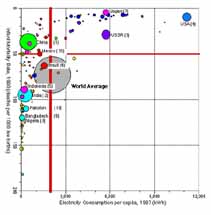 CLICK HERE TO SEE FULL PAGE IMAGE Figure 8. Infant Mortality vs. Electricity The World Health Organization and many hunger response groups have identified an Infant Mortality Rate (IMR) of 50 as the "point of no return" to a hungry nation status. No country which has achieved this level has ever gone back to an IMR of 50+. Gcina's emphasis on controlling birth rates and improving health care has resulted in lower than average IMR based on their electricity consumption. Many nations could significantly improve their IMR with increased availibility of electricity. Electricity provides the essential infrestructure for clean water, food preperation and refrigeration, and waste disposal.
As energy reaches 1000 kWh per capita, it appears that nations can anticipate at least a 50% literacy rate. At 2000 kWh per capita, they can expect over 85% literacy rate, and at 4000 kWh per capita, virtually 100%.
====
=== Many countries did not report on safe drinking water, hence some of the primary nations are missing from this chart. However, it is evident that an increase in energy consumption per capita brings sewage disposal and a greater ability to store, pump and filter water. Once a country reaches 2000 kWh per capita, they can expect that over 90% of the population will have potable water. HOW RESEARCH RESULTS WILL BE USEDGENI's purpose is to act as a catalyst in the use of electricity interconnections between nations and continents. The goal is to bring an adequate and sustainable energy supply and development services to all people. The international community must address the following key issues which are essentially the openings or obstacles to global implementation:
To compliment the international forum, GENI will actively research, design and prioritize energy generation and infrastructure projects on every continent. A GENI model report and Executive Summary will be prepared and widely distributed in a global education program to the international community in many different forms. These will include computer animations, documentary films and comprehensive information packets. The model results will quantify the benefits of global and regional planning and will assist in prioritizing the GENI strategy in relation to other energy strategies and technologies currently under discussion by the WEC, World Bank, United Nations, and other organizations. GENI results will be discussed at a proposed future conference co-sponsored by the United Nations, entitled "International Conference on Electrical Interconnections." The conference will bring together engineers, environmentalists, financiers and policy makers. The goal of the conference is to forge international alliances to start viable interconnection projects. GENI's goal is to provide a computer aided tool to help determine the most urgent and viable projects. DESIGN PROGRESS TO DATEThe initial talking model, addressing power generation real-time decision making, first "traded" electricity between regions in April, 1994. The talking model currently runs on a Macintosh Centris 650 personal computer with iThink modeling software. This model demonstrated the difficulties of modeling many concepts simultaneously. The scenario linked two regions together. The modeling software was the limiting factor. Modeling continuous and discrete variables, different time frames and event durations, all at the same time, was difficult to implement. Workstation or mainframe based modeling tools are believed necessary to accurately model the entire nine WEC regions plus global effects. The next talking model will study infrastructure creation, utilization, and decommissioning decisions. This is a necessary and more complex task than modeling "instantaneous" power generation decisions. MODEL LIMITATIONSElectricity distribution to end consumers will not be modeled by the GENI model. It has been well documented by the utility industry. In addition, the GENI model will not discuss the effect of the transportation sector on the dependent factors of electrical interconnections. This will become a critical next phase, especially when the electric car enters the market requiring recharging each evening. A prime question will be the shift of pollution effects from the tailpipe to the smokestack. If the generation mix over time can make the shift to renewables, the battery recharging would have minimal environmental effect. SUMMARYUtility grid system planners are facing an increasingly complex world. The current problems stopping expansion of existing local or regional electricity grids appear to be FINANCIAL, SOCIAL and POLITICAL considerations, rather than technical ones. As noted by Yuri Rudenko and Victor Yershevich of the Russian Academy of Sciences, the creation of a unified electrical power system would not be an end in itself.(19) Rather, it was their view, that a unified system would be the natural result of systems that demonstrated benefits in terms of economics, ecology and national priorities. Possibly the most encouraging endorsement for the linking of renewable resources comes on the heels of the Earth Summit in 1993 in Rio de Janeiro. Noel Brown, North American Director of the United Nations Environmental Program, stated that tapping remote renewable resources is "one of the most important projects furthering the cause of environmental protection and sustainable development." REFERENCES
AUTHORSPaul-Michael Dekker received a B.A.Sc.(Systems Design Engineering) from the University of Waterloo, Waterloo, Ontario, Canada, in 1980. Contact him via email at: byte.butler@pobox.com or telephone him at: +1 619-585-0158 Peter Meisen graduated with a degree in Applied Mechanics and Engineering Science from the University of California - San Diego, San Diego, California, USA, in 1976. He is the Founder of GENI, and began his research on global energy grids in 1986. Amy B. Bruton received a dual B.A. from Bates College and a joint M.A. in International Relations and Resource and Environmental Management from Boston University. She has written draft policy for the Hungarian government on the resolution of the Gabcikovo-Nagymaros Hydroelectric plant conflict. Amy has written an analysis of the IEA/ORAU long-term global energy-CO2 model, and has worked with various other global models. GENI is a tax-exempt organization based in San Diego, California, with affiliates in Canada, Australia, New Zealand, Singapore, Hong Kong, Germany, and Russia. GENI is conducting education and research into Buckminster Fuller's priority proposal for the planet -- the interconnection of renewable energy resources around the world. This global option is the highest priority solution from the World Game, whose purpose statement is: "How do we make the world work for 100% of humanity in the shortest possible time through spontaneous cooperation without ecological damage or the disadvantage to anyone." The authors acknowledge the contributions made by many people, including Joe Falcon, Past President of the American Society of Mechanical Engineers, Thomas Hammons, Chairman of International Practices Committee of IEEE/PES, Walter Venable (computer wizard, who prepared the graphs for this paper and worked with P-M.D. to design the first GENI talking model), Beth Brummitt for her constructive editing, Dr. Graeme Edwards, Barbara Karlin, Carol Resnick, Tom Zaengle, and the Mission Earth Task Force of the Society for Computer Simulation. |
